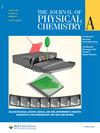What Role Can Surface Capping Ligand Play To Control Dopant Emission in Semiconductor Nanoparticles
IF 2.781
引用次数: 0
Abstract
The role of surface capping ligands in controlling dopant photoluminescence in semiconductor nanoparticles is examined by monitoring emission in terbium cation incorporated zinc sulfide [Zn(Tb)S] nanoparticles, as a function of [H+] that is varied postsynthetically. Increases in Tb3+ emission of ∼6 and ∼1.3 times are observed on changing the pH from 4 to 7 and from 7 to 11, respectively. An increased contribution of host sensitization over direct excitation is observed under basic conditions. Subtle structural modification of the capping ligand is argued to be solely responsible for the dopant emission in the acidic–neutral range. The neutral–basic range in addition to this effect has a minor contribution from alteration in band alignment as well. A major outcome from this work relates to identifying the role of the terminally placed functional group in the capping ligand to control emissions from both the host (zinc sulfide nanoparticles) and guest (Tb3+), with a pronounced effect on dopant Tb3+ emission in the 1-thioglycerol capped Zn(Tb)S nanoparticles. These results identify surface engineering as an important modulator, in addition to the primary criteria of (a) band gap engineering and (b) breaking (or optimizing) dopant local site symmetry in maximizing (or guiding) dopant emission in doped semiconductor nanoparticles.表面盖层配体在控制半导体纳米颗粒中掺杂物发射中的作用
通过监测铽阳离子结合的硫化锌[Zn - (Tb) - s]纳米颗粒的发光,研究了表面盖层配体在控制半导体纳米颗粒掺杂物光致发光中的作用,作为合成后变化的[H+]的函数。当pH从4到7和从7到11时,观察到Tb3+排放量分别增加了~ 6倍和~ 1.3倍。在基本条件下,观察到宿主敏化对直接激励的贡献增加。盖层配体的细微结构修饰被认为是导致掺杂在酸中性范围内发射的唯一原因。除了这种影响外,中性基范围也有很小的贡献来自波段对准的改变。这项工作的一个主要成果是确定了末端放置在盖层配体上的功能基团的作用,以控制宿主(硫化锌纳米粒子)和客体(Tb3+)的排放,并对1-硫甘油酯盖层zn - (Tb)S纳米粒子中掺杂剂Tb3+的排放有明显的影响。这些结果确定了表面工程是一个重要的调制器,除了(a)带隙工程和(b)打破(或优化)掺杂局部对称性以最大化(或引导)掺杂半导体纳米颗粒中的掺杂发射。
本文章由计算机程序翻译,如有差异,请以英文原文为准。
求助全文
约1分钟内获得全文
求助全文

 求助内容:
求助内容: 应助结果提醒方式:
应助结果提醒方式:


